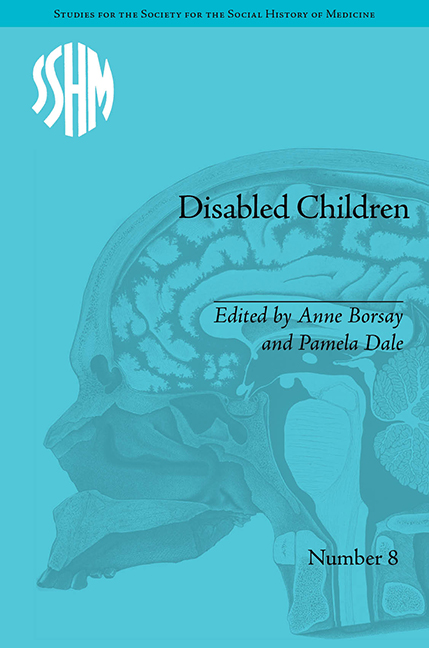Book contents
- Frontmatter
- Contents
- Acknowledgements
- Notes on Contributors
- Introduction: Disabled Children – Contested Caring
- 1 Club Feet and Charity: Children at the House of Charity, Soho, 1848–1914
- 2 Insanity, Family and Community in Late-Victorian Britain
- 3 The Mixed Economy of Welfare and the Care of Sick and Disabled Children in the South Wales Coalfield, c. 1850–1950
- 4 The Question of Oralism and the Experiences of Deaf Children, 1880–1914
- 5 Exploring Patient Experience in an Australian Institution for Children with Learning Disabilities, 1887–1933
- 6 From Representation to Experience: Disability in the British Advice Literature for Parents, 1890–1980
- 7 Treating Children with Non-Pulmonary Tuberculosis in Sweden: Apelviken, c. 1900–30
- 8 Health Visiting and Disability Issues in England before 1948
- 9 Spanish Health Services and Polio Epidemics in the Twentieth Century: The ‘Discovery’ of a New Group of Disabled People, 1920–70
- 10 Cured by Kindness? Child Guidance Services during the Second World War
- 11 Education, Training and Social Competence: Special Education in Glasgow since 1945
- 12 Hyperactivity and American History, 1957–Present: Challenges to and Opportunities for Understanding
- Notes
- Index
3 - The Mixed Economy of Welfare and the Care of Sick and Disabled Children in the South Wales Coalfield, c. 1850–1950
- Frontmatter
- Contents
- Acknowledgements
- Notes on Contributors
- Introduction: Disabled Children – Contested Caring
- 1 Club Feet and Charity: Children at the House of Charity, Soho, 1848–1914
- 2 Insanity, Family and Community in Late-Victorian Britain
- 3 The Mixed Economy of Welfare and the Care of Sick and Disabled Children in the South Wales Coalfield, c. 1850–1950
- 4 The Question of Oralism and the Experiences of Deaf Children, 1880–1914
- 5 Exploring Patient Experience in an Australian Institution for Children with Learning Disabilities, 1887–1933
- 6 From Representation to Experience: Disability in the British Advice Literature for Parents, 1890–1980
- 7 Treating Children with Non-Pulmonary Tuberculosis in Sweden: Apelviken, c. 1900–30
- 8 Health Visiting and Disability Issues in England before 1948
- 9 Spanish Health Services and Polio Epidemics in the Twentieth Century: The ‘Discovery’ of a New Group of Disabled People, 1920–70
- 10 Cured by Kindness? Child Guidance Services during the Second World War
- 11 Education, Training and Social Competence: Special Education in Glasgow since 1945
- 12 Hyperactivity and American History, 1957–Present: Challenges to and Opportunities for Understanding
- Notes
- Index
Summary
Introduction
Historians of welfare have utilized the idea of a mixed economy of care to explain the various combinations of welfare providers in different contexts in the past. They have used the concept as a means to better convey the balance and interaction of public and private forms of provision in any consideration of the welfare system and as a means to examine the provision of welfare in its totality; for a later period, the phrase very usefully reminds us of the variety of providers overlooked by use of the term ‘welfare state’. In contrast to discrete studies of particular institutions or organizations, the concept changes the focus from a particular initiative to give more attention to the precise ways in which communities made provision for particular groups of the population or for distinct social ‘problems’, the conditions under which they did so, and the differential impact made by provision from different providers.
Despite criticisms of the étatist orientation of earlier accounts of welfare provision and the corresponding neglect of other, non-state providers, advocates of an approach that utilizes the mixed economy of welfare as a conceptual tool nevertheless adopt the state as the unit of analysis. Reminders that the mixed economy varied in space only seem to recognize that it did so between states and neglect to observe that it also varied within states. To date, very little attention has been paid to the regional or local particularities of the mixed economy of care.
- Type
- Chapter
- Information
- Disabled ChildrenContested Caring, 1850–1979, pp. 43 - 58Publisher: Pickering & ChattoFirst published in: 2014



